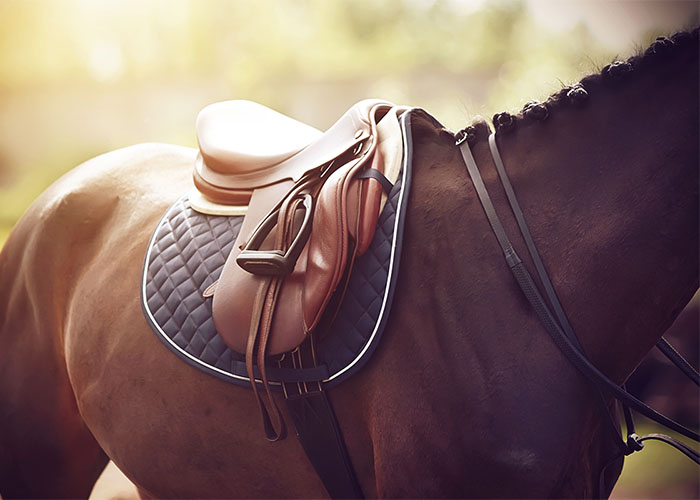
After taking lessons for a number of years, many equestrians are ready to begin their journey into horse ownership. In addition to buying your first horse (you can learn more about that process in our blog post, Purchasing Your First Horse) and potentially building a farm (learn more by reading, Bringing Your First Horse Home), you will also need to make an additional set of purchases for your horse. Generally, equestrians ride one of two different disciplines, Western (such as western pleasure, reining, horsemanship, or cutting) or English (dressage, hunter/jumper, and saddle seat are all considered English disciplines). In this blog, we outline the basic tack and equipment that you will need to safely handle and ride your new horse, however, it is important to realize that your equipment will vary depending on your discipline. To learn more about caring for your tack after your purchase, we encourage you to read the article, TLC: Tack Love and Care.
Heading Out to Shop
When you head off to the tack shop, it is important to be armed with as much information as possible. When you try out the horse, ask the current owner and/or trainer as many questions as you can think of, including “What kind of bit does he or she prefer?” and “What size tree is this saddle?” This information will assist the sales staff in helping you find the appropriate tack for your horse. If possible, take pictures of the tack that is being used on the horse when you go to try the horse.
In addition to photos and details about the tack, we will want to know all about your horse! Bring in a few of your favorite photos, this will help us to determine your horse’s general shape and size (we are also excited to admire the new horse!). If you have measurements, such as height or girth size, also be sure to mention this to the sales staff as well.
The Basics
There is a wide variety of tack and equipment that you will see when you head to your local tack shop. You may find, as you own your horse for longer periods of time, that you need to expand your tack collection. However, in the beginning, it is best to start with the basics as you determine your preferences as well as what your horse does and does not need.
Halter and Lead Rope
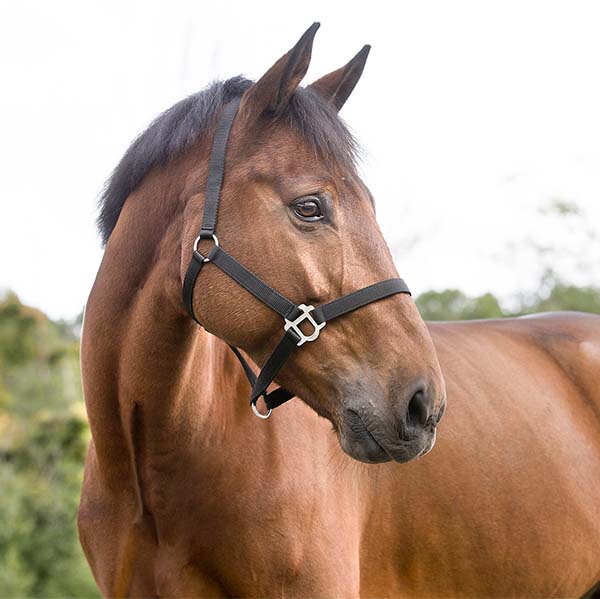
Used in conjunction with one another, the halter and lead rope are how you lead your horse and control them during groundwork sessions. They are probably the most used piece of equipment that you will purchase for your horse. The halter goes around the horse’s head, circling the nose and resting behind the horse’s ears; many models feature a clip in the jowl area to make it easy to put the halter on and take the halter off your horse. The lead rope generally clips to the ring on the bottom of the halter and helps you to control your horse’s movements.
There are many different models of halters and lead ropes available on the market. When making your purchase, you will want to think about your horse’s demeanor and how you plan to use the halter. Nylon halters are economical and popular for daily use, however, they are not recommended for turning your horse out, because they can cause injury if the horse were to get caught – nylon does not break. Leather halters are an excellent option for daily use, but they will require additional care to maintain the integrity of the leather. If you will be turning your horse out in the pasture wearing its halter, a breakaway halter is a great choice. Breakaway halters are nylon halters with a leather crown piece; this leather strap breaks easily in the event of an emergency, which keeps your horse safe.
When it comes to selecting a lead rope, you will want to think about its use as well as your horse’s temperament. Many equestrians like the cotton rope lead ropes, because they are comfortable in your hands and easy to grasp. Other horse enthusiasts prefer using rope, leather, or nylon lead ropes. This is truly up to your personal preference and what feels appropriate for your hands. Additionally, you will want to consider if you want a lead rope with a snap or a lead rope with a chain shank. Many horses are respectful enough to simply use a snap, but other horses may try to take advantage of a beginner owner and may require a chain shank. If you use a chain, be sure that you are using it properly and under the guidance of an experienced equestrian.
Saddle
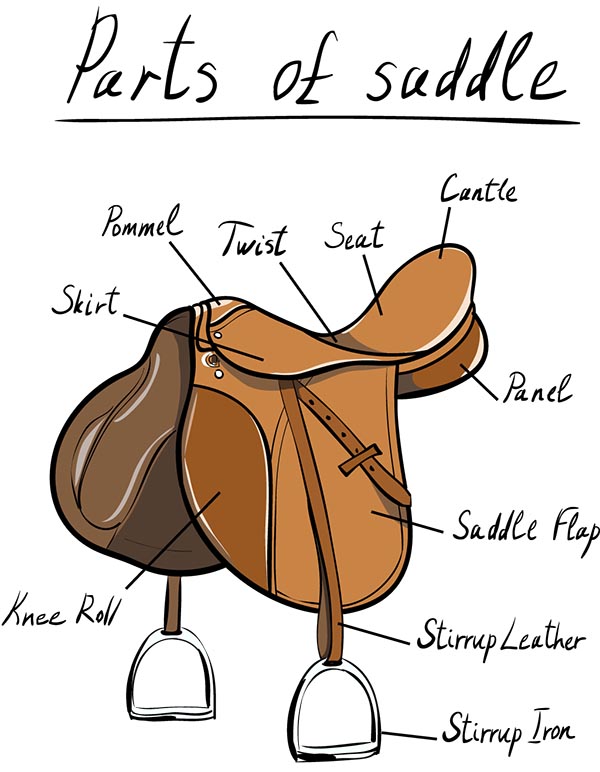
The saddle is perhaps one of the biggest and most important purchases that you will make for your horse. It is essential that you select a saddle that is properly sized for both you and your horse. An improperly fitting saddle can create painful pressure points and muscle soreness in your horse’s back, just like a pair of improperly fitting shoes can cause you tremendous pain. You can learn more about the importance of saddle fit on our blog post, The Effects of Poor Saddle Fit.
Thankfully, there are trained professionals, called saddle fitters, who can help find the right saddle for you and your horse. They are truly worth the money, ensuring that you are investing in a saddle that will complement your horse’s conformation. A poorly fitting saddle is a health issue as well as a safety issue.
The saddle fitter will assess the general shape of your horse’s back and take a variety of measurements, including your horse’s “tree” size (the tree is the width of the saddle and the angle that it meets up with the horse). This will help narrow down the choices of what specific saddle is the best fit.
Some English saddles, such as the Wintec and Bates Saddlery lines of saddles, feature adjustable gullets (trees). These are a great option for people who are just starting out because they can be modified to fit a number of different horses. A saddle gullet gauge can help you determine the proper size gullet (tree width) for your saddle, but these saddles should still be customized under the guidance of a trained saddle fitter.
There are two main types of saddles, Western saddles and English saddles. Then there are a number of different styles depending on the discipline of the horse and rider. Generally speaking, a Western saddle has a horn and is larger than an English saddle; the stirrups and stirrup leathers are also integrated into the saddle design and are not sold separately. English saddles have a smaller profile and tend to give the rider a closer connection to the horse, they also do not have a horn. When shopping for a saddle, it is important to know what you would like to do with your horse (pleasure riding, trail riding, dressage, jumping, etc.) so that you can choose an appropriate saddle for your goals.
When shopping for a saddle, it is important to ask for assistance to find a saddle that fits you and your horse properly. At The Cheshire Horse, we offer a comprehensive saddle trial program so that you can ensure it is the right saddle for you and your horse, learn more about The Cheshire Horse Saddle Trial Program. A well-fitted saddle is an investment that will last for many years.
Bridle and Bit

It is important to pick a bridle and bit combination that your horse is comfortable with. Every horse has a differently shaped mouth and preferences when it comes to a bit. Be sure to talk to the previous owners when trying out the horse to learn about what bit they are currently using and why. You may choose to change the type of bit in the future, but typically it is best to use the same bit with the horse in the beginning if the horse has been comfortable.
Bits are measured by the width of the mouthpiece. A bit that is too narrow will pinch your horse’s lips, while a bit that is too large will slip around in your horse’s mouth. A bit sizer is a plastic piece that fits into your horse’s mouth (just like a bit) and allows you to determine the proper sized bit for your horse. You can learn more about bit sizing on our blog post, How to Properly Fit a Horse Bit.
When shopping for a bridle, it is helpful if you understand the various sizes available. Generally, English bridles come in Pony, Cob/Arab (small horse) Horse/Full, Warmblood/Oversized/Extra Full (large horse), and Draft Horse sizing. Western bridles (headstalls) will come in Pony, Horse, and Draft Sizing and are highly adjustable. The size that you select will depend on the size and proportions of your horse’s head; the sales associates at your local tack shop can help you to determine the right size for your horse (remember to bring those measurements and photos with you!).
Some bridles come with reins, but other bridles require the reins to be purchased separately. The size of the reins is determined by the length of the reins: 42” (pony reins), 54” (normal rein length), and 60” (long neck horses or draft horse sizing). There are also many types of reins, leather, rubber, fabric webbing, and more. Again this choice depends on your personal preference and what type of riding you will be doing.
Stirrups and Stirrup Leathers
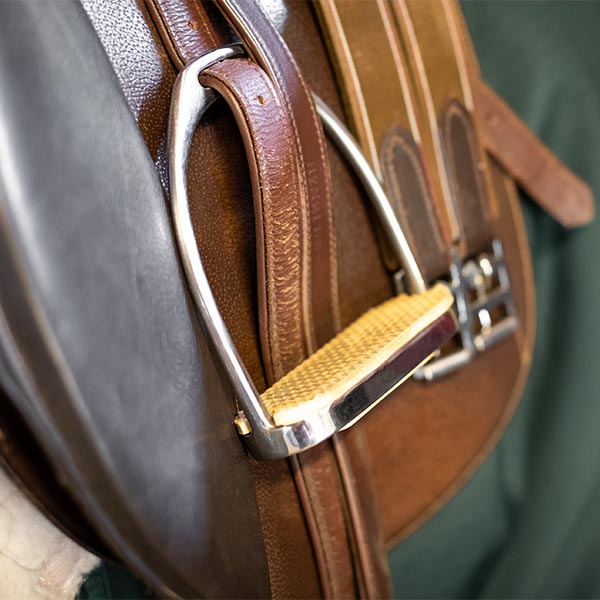
When purchasing a new (or new-to-you) English saddle, it is important to realize that stirrups and stirrup leathers are not included. There are a number of different styles of stirrups, including peacock stirrups (breakaway stirrups), Fillis stirrups (traditional stirrups), and flexible stirrups. Stirrups can also be made in a variety of materials including stainless steel and composite plastics.
New riders often benefit from breakaway stirrups, which release your foot in the event of a fall. These stirrups can also be referred to as peacock stirrups and safety stirrups. Riders with bad knees often prefer flexible stirrups, which are designed to take the pressure off of your knees when riding.
The size of your stirrups is mainly determined by the width of your foot because the sizing of stirrup refers to the width of the footbed. The size of the stirrup that you need will depend on your riding boots as well, with many riders finding that they need different-sized stirrups in the winter months when they are wearing insulated boots. It is important that you have properly sized stirrups so your foot does not become lodged in the stirrup, which is very dangerous.
Stirrup Size Guide
| Size | Size of Rider |
| 3.5-4” | Child |
| 4.25” | Small Adult |
| 4.5-4.75” | Average Adult |
| 5” | Average Men (and Winter Riding) |
When it comes to stirrup leathers, there are generally only a few decisions that you need to make. Stirrup leathers are made out of either leather or synthetic materials; typically, equestrians will purchase the material that corresponds to the type of saddle that they have, however, either type is appropriate. Lined leather and synthetic leathers are popular because they do not stretch with use. You will also need to determine which length of stirrup leathers to buy. Refer to our size guide below, but understand that your size may be different based on your individual proportions.
Stirrup Leather Sizing
| Length | Size of Rider |
| 48” | Child or Petite Adult |
| 54” | Average Adult |
| 60” | Tall Adult or Dressage Rider |
Saddle Pads
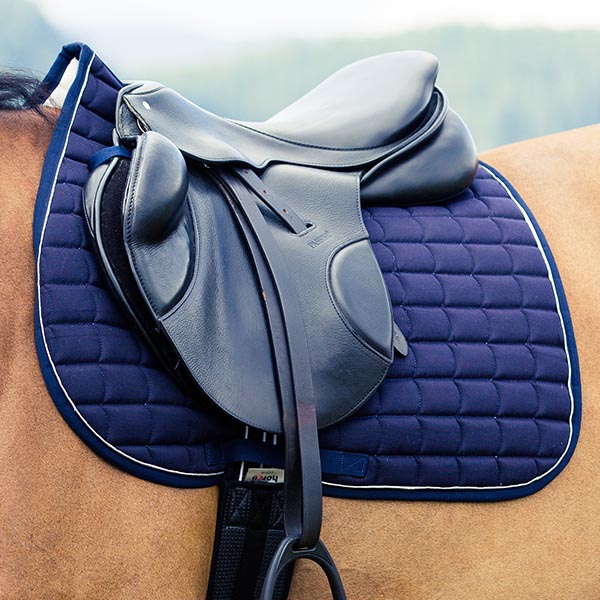
Saddle pads protect your saddles and give your horse’s back additional padding and cushion. The type of saddle pad that you need will depend on the type of saddle that you have. For example, a dressage saddle will require a dressage pad and an all-purpose saddle will need an all-purpose saddle pad. Western saddles are designed to have thicker padding underneath them and will require a Western pad. Your saddle fitter can help you determine if your horse is a candidate for half pads or therapeutic saddle pads, which modify the fit of the saddle and can make it fit your horse better (when used properly).
Saddle pads are also your opportunity to let loose and have a bit of fun with your riding apparel. They are available in a wide variety of fun colors and piping options at reasonable prices. You will most likely want to purchase two saddle pads so that you always have a clean option whenever you are at the barn. Additionally, if you plan to compete, you will want an additional white pad (for English riders) or a pad to match your outfit (for Western riders).
Girths and Cinches
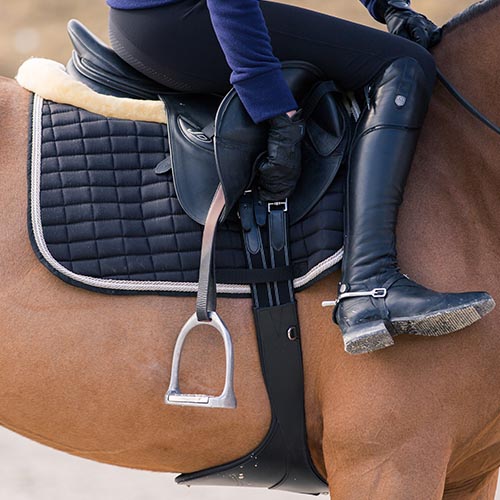
English Girths and Western Cinches keep your saddle properly positioned and prevent them from slipping. Girths and cinches come in two different styles: long girths and short girths. What length of girth you purchase will depend on your saddle; long girths tend to go with hunter/jumper saddles, while western saddles and dressage saddles will use short cinches or girths. Generally speaking, your horse’s long girth will measure 20” longer than their short girth (for example, a horse wearing a 48” long girth will most likely wear a 28” short girth).
Girths and cinches come in a variety of materials, and your horse’s needs will help determine which material is right for you. Fleece-lined, leather, and synthetic girths are popular choices for English riders, while Western riders tend to prefer felt, fleece, mohair, and neoprene cinches. Many tack manufacturers have begun making anatomically shaped girths, which give additional room for the elbows. They also prevent the girth from rubbing on sensitive skin, making them a great option for horses who are prone to girth sores.
If you know what size girth your horse was previously ridden in, it will make it much easier to purchase a girth for your horse. Make sure that you ask when you are trying the horse to make the shopping process simpler.
Additional Accessories
There are a number of other tack accessories that equestrians purchase for their horses. Your horse may or may not need them in the beginning, but it is a good idea to have knowledge about their use and purpose.

If your horse is highly sensitive to flies and bugs, an ear net can make your ride more enjoyable. They fit underneath the headstall of the bridle and protect your horse’s ears and forehead from pesky biting insects. They also come in a wide variety of colors and styles, making them a fun fashion accessory for your ride! Fly masks are used to protect your horse’s eyes and face from flies and biting insects when you are not riding your horse.
Depending on your experience level and your horse’s demeanor, you may need a crop or whip. This artificial aid acts as an extension of your leg aid and, when used properly, can help you encourage your horse to move forward and off of your leg. They should only be used under the tutelage of an experienced equestrian until you are comfortable using them appropriately.
If you are riding Western, you may need a breast collar. These straps run from the front of the saddle, across the horse’s chest, and back to the saddle. This helps to keep the saddle properly positioned and helps prevent it from sliding back onto the horse’s loins.
Some horses need leg protection, such as bell boots, polo wraps, or open-front boots, to support their tendons and help prevent cuts, scrapes, and/or pulled shoes. This is largely dependent on your horse’s conformation as well as what job you are using your horse for (i.e. a horse that jumps may require more protection than a horse that pleasure rides). Talk to your riding instructor, equine mentor, farrier, or veterinarian to see if your horse is a candidate for leg protection.
Neck-straps and saddle handholds provide additional security in the saddle and allow you to grab onto something other than your horse’s mouth if you get into any trouble during the course of the ride. They are popular among beginner riders and experienced riders alike, with many experienced equestrians utilizing them when riding a green horse.
When it comes to tack shopping for your new horse, this is a fun and exciting time. If you have any questions about the right tack for your horse or what size is best, please ask for assistance. The best tack for your horse is safe and well-fitting.
At The Cheshire Horse, we love helping new horse owners on their equestrian journey. Our friendly and experienced sales staff is always available to answer your questions and help you finalize your purchase. If you have any questions, please reach out to us; we look forward to speaking with you!
